Chalus Road or “Jade Chalus” or any other transit route to the north of Iran, or how Iranian call it “Shomal”, are not just candy-twist steep paths and highways through the long stream of Alborz mountains isolating the north of the country from the rest of it, they are green pathways to scarcely touched Persian (Iranian) heavens with traffic jams over the holidays that could make you feel the hell that was prophesied in the Great Testimony and Jesus warned us all about.
Jade Chalus has been named the dream road of Iran with millions of people annually driving their cars to get to Shomal or just to have a fun happy family picnic in one of its numerous on-the-road restaurants which have beautifully integrated themselves with the surrounding nature. It’s a hard quest finding an Iranian who hasn’t left his heart on this lavishing road and not get enchanted by its natural marvels.
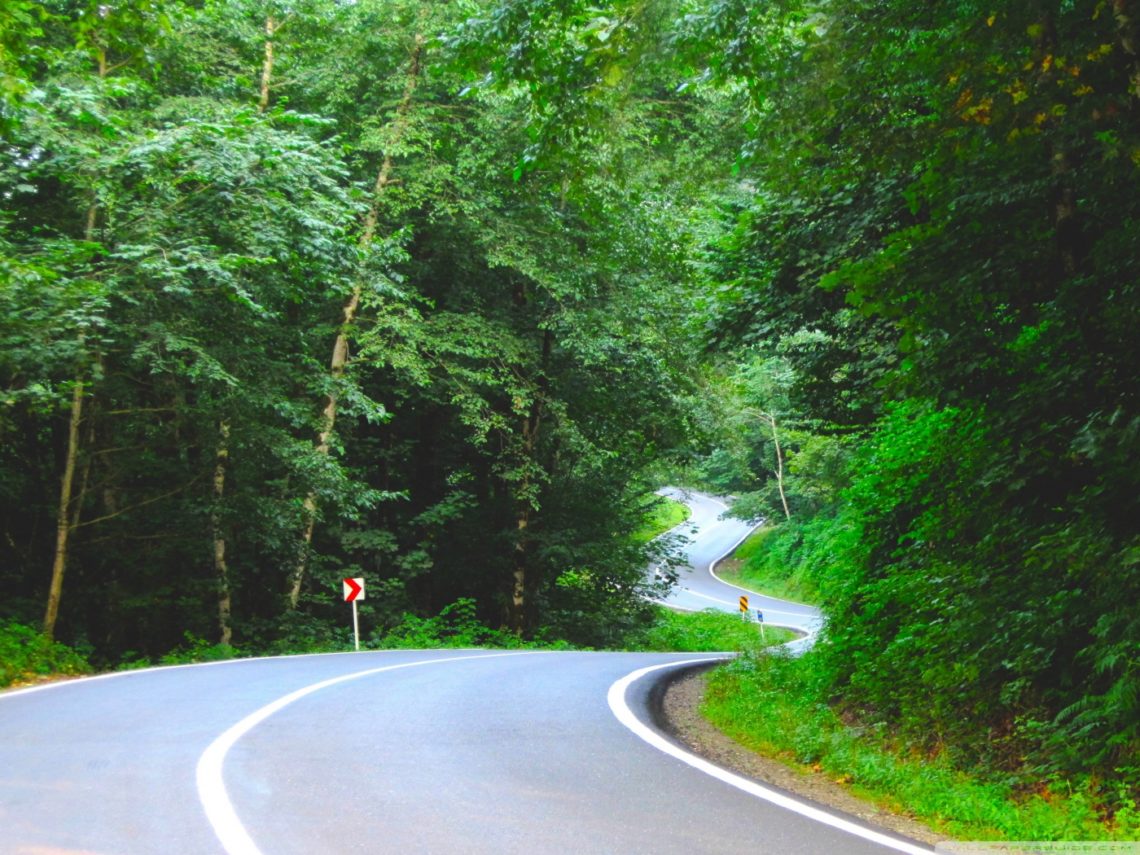
The beautiful Chalus road
All that being said, it’s an offense to lots of other magnificent scenic roads in pretty much every direction of Iran to name Chalus the dream road of Iran but, nonetheless, we are going over this amazing haven of a route that without the slightest amount of doubt is one of the top scenic roads in the land of Persia.
History of Chalus Road
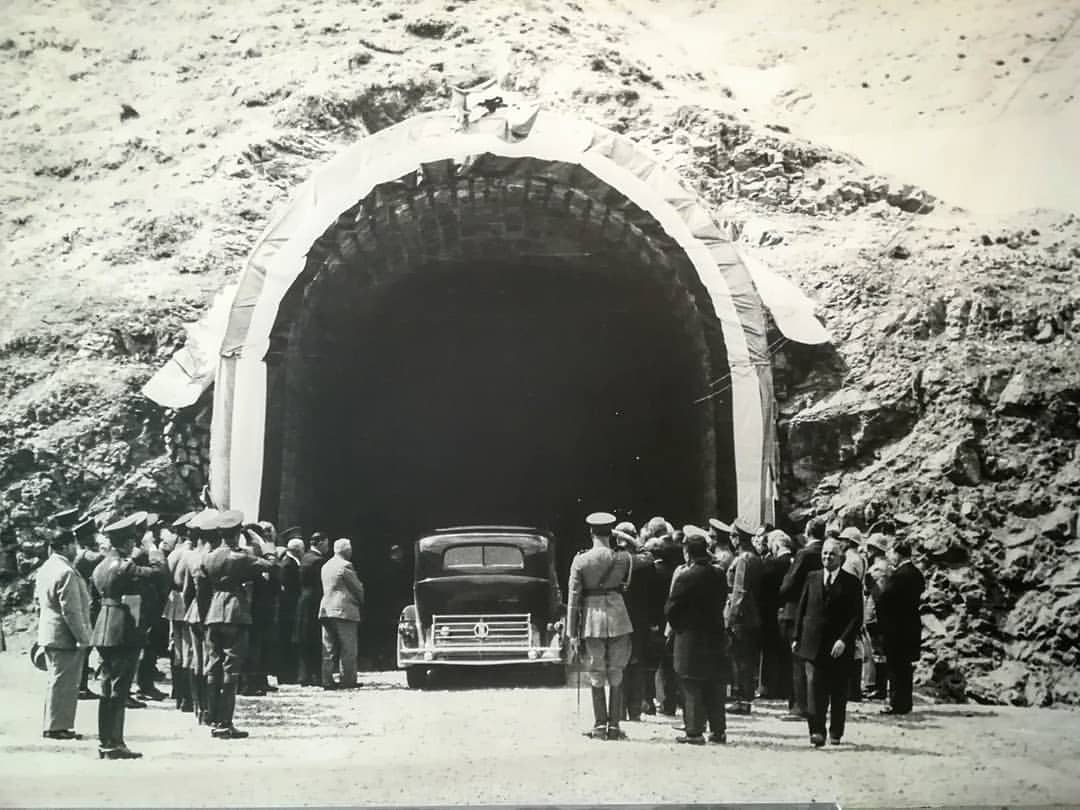
Chalus Road in ancient times, Iran
The history of this beautiful road is as interesting as its diverse scenery. Jade Chalus, or Kandovan road or the famous “route 59”, takes us back to the year 1931 and the early days of the Pahlavi dynasty when the first moves to pave this road with concrete and asphalt started. Under the influence of the British army, which, by the way, invaded Iran despite the fact of Iran’s neutrality in World War 1 in fear of the country’s tendency to join the Axis powers, the lack of a well-structured stable paved road to the north put the allied forces in quite of a pickle and the British decided to modernize the Chalus Road. However, even before the great war and the British occupation, Naser al-din Shah, the infamous Qajari Shah, had mentioned the name of Kandovan in his travel diaries and the fact that he, at some point, needed to take a route to cross the hazardous Kandovan pass.
Also check out: The best road trip in Iran to take by bus
Reza Shah, the fierce and relentless king of Iran in the few early years of the Pahlavi era, made sure that this road is fully operational and to solve the problems that the Kandovan pass put in front of travelers, he ordered the construction of Kandovan tunnel. Back then, a project at this caliber would take years and a huge amount of investment to be completed and for the project to continue without the threat of it coming to a halt, Reza Shah personally supervised the development of the tunnel and kept a close eye on the project.
You can book Iran buses online through 1stQuest.com
Today, the dream road of Iran – Chalus Road, spans for over 160 Kilometers connecting the busy city of Karaj, the capital of Alborz province, and its neighboring city, the infamous crowded city of Tehran, through Alborz mountains and Mazandaran province to a more green city at the shores of the Caspian Sea by the name of Chalus. This road is widely popular and is shut down countless times over the winter season due to the risk of avalanches or heavy snowfalls. Nonetheless, nature can’t be solely blamed for one of Iran’s dreamiest road’s many blockades. Millions of people tend to swirl onto Jade Chalus and cripple the tiny pathway and build such a traffic jam that can go on for days during major holidays and thus, forcing the hand of Iranian traffic police to put an one-way restriction law in order on Chalus Road so it can maintain a more fluent traffic and the fact that if this doesn’t happen, some people might don’t even get the chance to see the coastline of the Caspian Sea along the road, let alone reach it!
Also check out: Iran’s Secret Backpacker Destinations
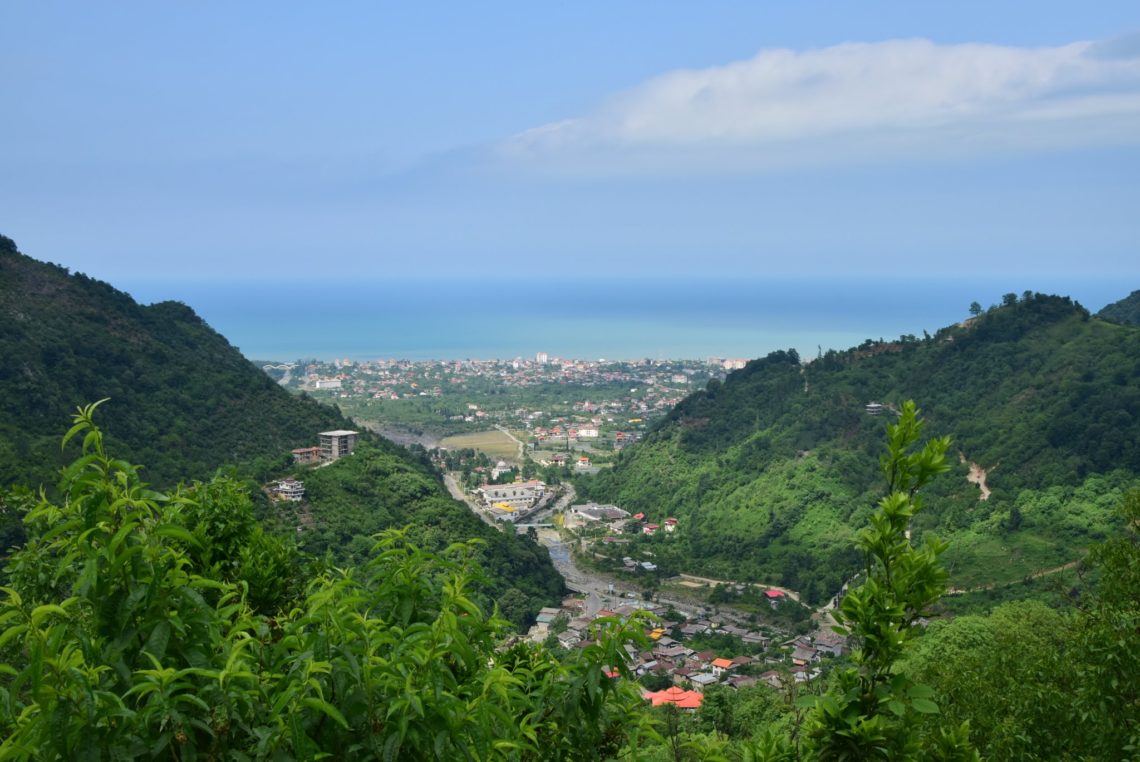
Caspian Coastline, Iran
What Jade Chalus means to the people?
Over the past decades, quite of few new roads and highways have been constructed to potentially take some traffic load of the historic Chalus Road and inevitably convince the people that other routes can not only be as fun as Chalus Road, but also serve them as high-speed multiple lane highways so they can get to their destinations quicker. However, it seems that the Persians are not having any of it and when something of great historic and environmental value grows root in their souls, it’s hard to get it out.
The dream road has manifested itself deeply in the social consciousness and the emotional bonds of the Iranian people. Persians don’t just go to Chalus Road for a good time, they go there to reaffirm their vows and faith with nature and to answer its call.
Driving on Chalus Road is a way for the Iranians to get back together and put a distance between themselves and the hassle of big cities who covered them in clinging black cloud of pollution, an unwanted gift from cities undergoing massive changes and becoming a more modern metropolitan.
Also check out: Experience Iran’s Lush Wilderness in Gilan
Road Trip on Jade Chalus
The advent of this picturesque mountainous routes on the feet of Alborz mountains brought a pack of opportunities for unforgettable drives, mountain climbs, and nature tours that could end in a deep sleepover in a rural house squeezed inside a bushy jungle. Thousands of nature-lovers pack their bags each weekend and start their car’s engines for a quick drop-in into the untouched lands to reunite with their true inner self and break free from the mechanical and unoriginal lives that metropolitan have to offer.
A road trip on the enclosed Jade Chalus rises more in popularity in Iran with the development of new technologies that nail us steadier in our chairs and cuffs our hands tighter to our smartphones. Although a normal road trip on Chalus road doesn’t come into many complications, however, if interested, you can book a tour to mountainous villages few thousand of meters on top of Alborz heights or you can tune in to a one day trip to other phenomenal natural and synthetic wonders along the northern paths like a trip to the famous Veresk bridge or day trip to the naturally-cause freshwater Valasht lake a thousand meters above the Caspian Sea level that neighbors the heavenly lands of Kelardasht that boasts with small and big mix of villages in eye-catching colors and traditional villagers.
Also check out: The best beaches in Iran
How to see the eye-catching Jade Chalus?
If you’re spending your time on the southern middle of Iran, chances are that you can’t buy a direct bus ticket that takes you through the mountains of Alborz on Jade Chalus and you need to get a bit more closer to Shomal and then find a bus ticket, unless you’re crazy rich and are thinking about renting a car or getting a private cab that is going to cost you a few hundred bucks but it would be definitely worth it and you’d have the time of your life.
For the holiday-thirsty people in cities that do have direct access to the green stray of Shomal, however, things are a tad simpler. Scheduled buses leave terminals in almost every single one of these cities for a fantastic drive on Chalus road and through the mythical and misty mountainsides of Alborz heights.
What Jade Chalus feels like?
Like any other road in the world, the sensation slowly takes over you and the longer you observe the beauties of one of Iran’s dreamiest roads, the more you start to lean in into its mesmerizing green sights. Even if you’re suffering insomnia and your eyes are just about to shut, the first glance over the valleys and the stone-bedded Karaj river with crystal clear water gently brushing against the river banks turn the first few minutes into a rush of whole new energy taking over your body. As you move on further on this dreamy rode, dry mountains start to close in on you and swallow the space around your vehicle and rock-walls creep towards you until they are at hand’s reach; the path follows quickly and before you know it you are surrounded by untouched nature. The real excitement now starts to kick in and the rock-walls only a few inches beside you slowly begin to hypnotize you until you can’t keep your eyes off of them. The relaxing river sounds compliment the eye-dropping scene of the rock-walls surfacing only one wish upon your other thoughts; I wish this wouldn’t end.
As the road goes on, other valleys in various schemes and Trees in bright red, dark green, and lightning yellow emerge in a constant battle to see which one can buy more attention for itself. On top of this colorful struggle, the clear blue sky seems lonely and only by joining forces with the trees, the gorgeous valleys, and the calm water they can truly be the heaven everybody wants them to be.
As your vehicle climbs higher on the mountainside, more and more draw-dropping sights come into view until at the altitude of 1600 meters above sea level and not so far from the beginning of the road in Karaj, the enormous body of Amir Kabir Dam Lake slowly dominates the landscape after a bend in the road. The peaceful turquoise-colored water behind the dam just makes you want to have a dip into it so you can float on it. Though a luring temptation, a dip into the dam lake is prohibited like many other beautiful dangerous threats the alluring mountains of Alborz hide under the bushy forests.
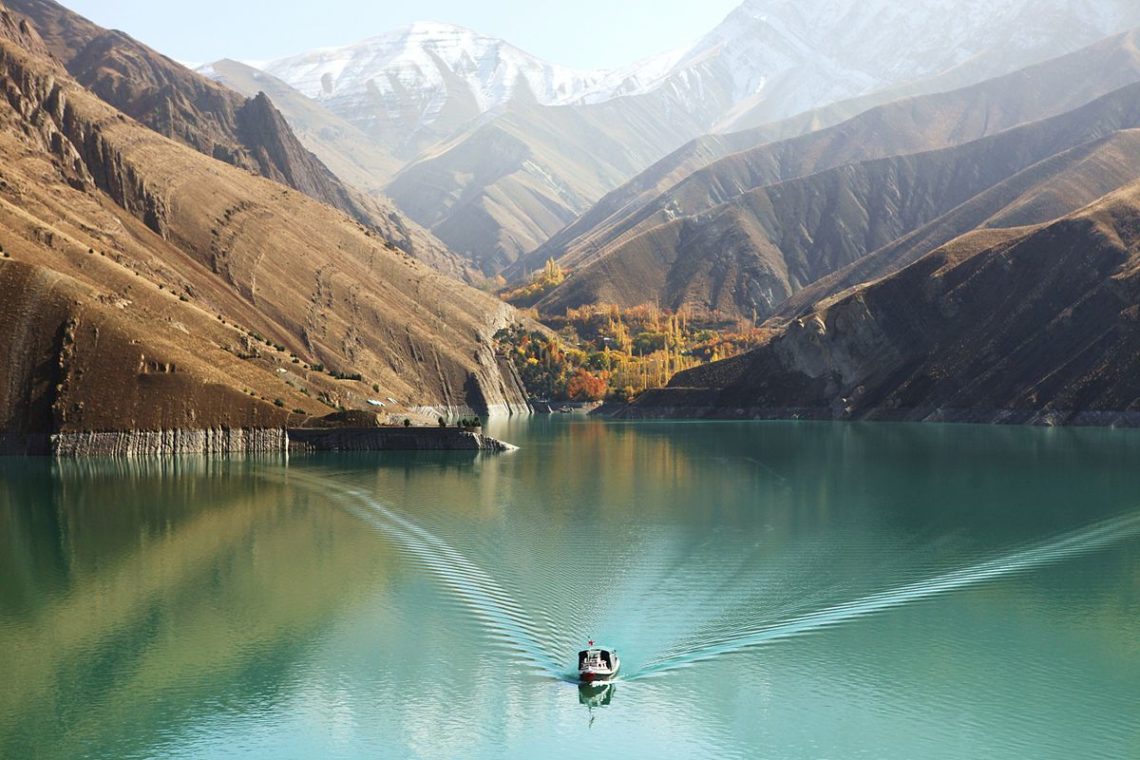
Amir Kabir Dam Lake, north of Iran
Don’t fall for the temptation
The jagged cliffs, old-growth beech forests that mask the surface of the rocky mountains in warmer days are home to different species of wolves, lynxes, and bears that to an unskilled climber all mean death, and this is just in hotter seasons. In winter, the rainy clouds swoop over these mountainsides to drop their load and bless the forests but the temperatures are so low that the water freezes and covers both the road and the mountain with snow, making them dangerous for climbers and drivers alike. In a more dire situation, avalanches and heavy snowfalls, the broods of the winter snow sometimes crash into asphalt Chalus road and cause its shutdown for a few days and even weeks in colder weather.
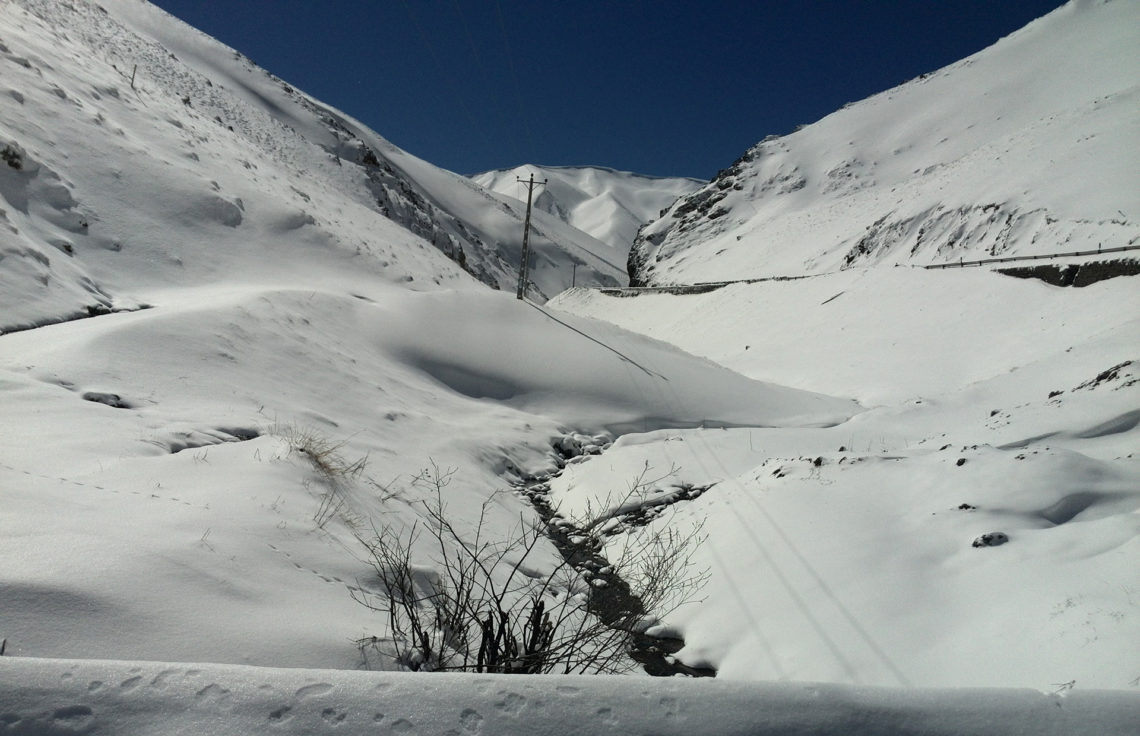
Snowy Chalus Road, Iran
Down to the riverbank
While most local people are pretty much used to the unparalleled natural features of this scenic roads, the new people sometimes jump out of excitement and don’t feel ashamed to use every pit stop as an excuse to let some of it out. At every stop, most strangers to this awe-inspiring wild road, climb down (if possible) to the calm river’s bank for a closer view of the breath-taking scenery and for a deep breath of mountain air that does not exist at each ending point of Jade Chalus, where the large cities and their relentless factories take in all the good air and exhaust heavy and polluted dark air for the people to live on. Watching the road and its glamorous surroundings from the window of a moving vehicle is one thing and feeling the light-yellow leaves of a tree that nobody knows how old it is or feeling the cool calm water slip through your fingers is another thing.
Why is it important?
Stranger or not, you have to reserve on your Iran’s itinerary to observe the never-ending beauties of one of Iran’s dreamiest mountain roads. It collects the feeling and the true essence of Persian people and holds many stories of their past and present and it will be still going from Karaj to Chalus way after any of us. Chalus Road has a soul in its every bit of concrete, rock-walls, steep bushy forests, misty mountain picks, and the joyful villagers on the cliffs that are never too shy to invite you to their wonderfully-colored huts for a warm tea.
